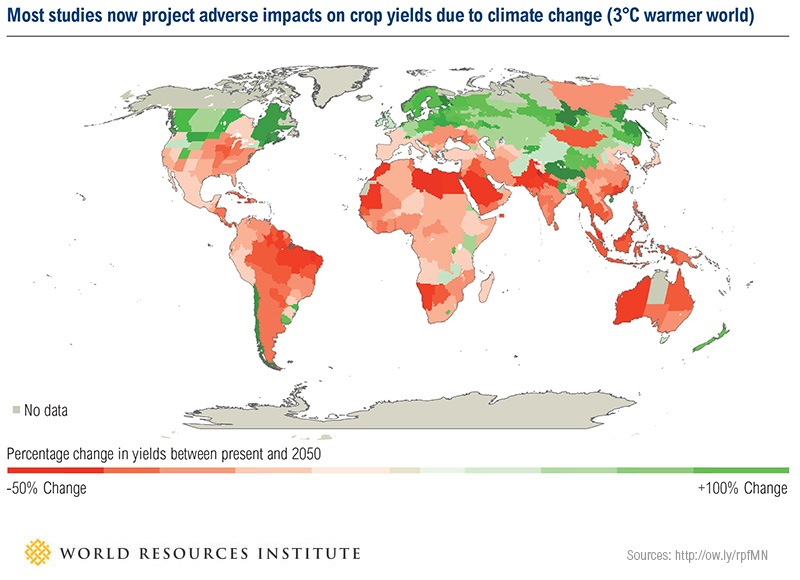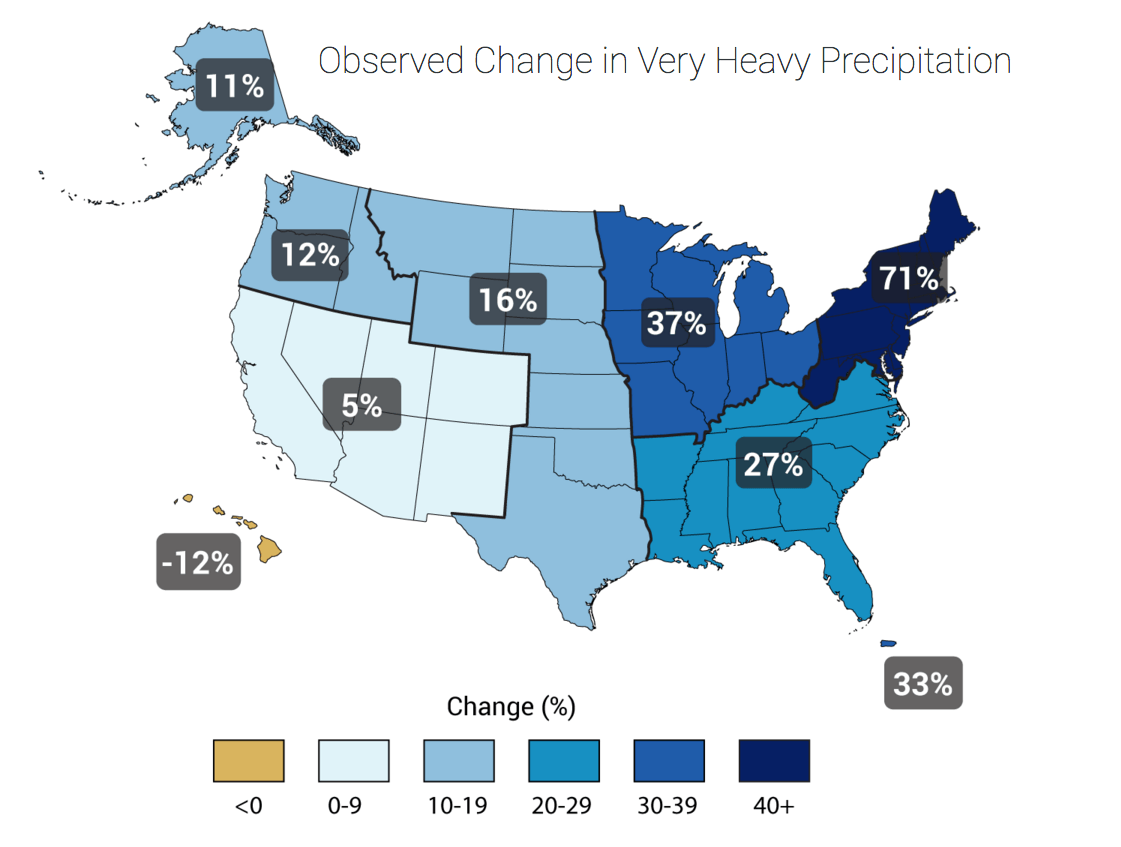Whole Foods Not Wholly Prepared for Climate Change

Whole Foods Market’s leading industry position has not fully translated to a leading role in preparing for and combating climate change.
Since its first store opening in 1980, Whole Foods Market has emerged as the leading supermarket of natural foods, generating over $15bn in annual sales with over 400 stores [1]. Whole Foods’ success is applauded by many for pioneering the mainstream delivery of organic and natural foods, while others critique the exorbitant prices they face at “Whole Paycheck” [2]. Regardless of its success and reputation, Whole Foods will be challenged by climate change and has already undertaken several measures as a result, but can do more.
What are some ways that climate change could impact Whole Foods?
Diminishing crop yields: Climate change has potential to reduce crop yields which will challenge Whole Foods to maintain its diverse range of quality products. With global temperatures predicted to potentially increase 3 degrees C by 2050, Whole Foods will face declining crop yields and reduced variety, particularly in products from areas most likely to be impacted such as South America [3].
Disrupted distribution: Whole Foods relies not only on its producers, but also on its distribution network to deliver its products from around the globe to its stores. With only 24% of its products sourced locally, the majority of products require a complex network of domestic and international producers and distributors [1]. Flooding is one specific problem that damages roads and warehouses, creating backlogs and spoilage [5]. In the US, where a majority of Whole Foods stores are located, extreme rain and floods will be further exacerbated by climate change, challenging Whole Foods’ distributors to deliver its products as forecasted [6].
Costly regulation: With increasing scrutiny on food waste, the USDA and the Environmental Protection Agency (EPA) have called for a 50% reduction in U.S. food waste by 2030 [7]. Additional costs could also impact several components of Whole Foods supply chain if a carbon tax were to be enacted as US states push for reform or impose higher oil and gas taxes [8].
What is Whole Foods currently doing to prepare for these climate change challenges?
Diversifying its producers: Recognizing the benefits of sourcing products from a diverse set of agricultural producers, Whole Foods has committed $20 million in low interest rate loans and mentorship programs to local producers. Aside from goodwill, this initiative expands the pipeline of products Whole Foods can access, which may mitigate overall declining crop yield by giving them access to a more diversified set of producers.
Optimized its supply chain management: Whole Foods is combating potential distribution disruptions by upgrading its supply chain management system to a “single-view” cloud-based software, expected to save $300 million by 2017 [10]. This system creates short term efficiencies and also helps Whole Foods better navigate climate change challenges to distribution, such as flooding, by increasing transparency through the entire supply chain (e.g., diminishing the bullwhip effect).
Reduced its food waste and fossil fuel reliance: Whole foods publicly states its commitment to aid in reducing food waste in line with the USDA’s target by 2030 [7]. Stores have developed a process for packaging, refrigerating and donating a wider range of foods, including items from their buffets stations. As an example, in the first half of 2016, stores in the Southeast U.S. donated more than 1.4 million pounds of food to Food Donation Connection [7]. Turning to the sustainability of its energy needs, Whole Foods has purchased an increasing amount of energy from green energy sources, recently ranking #3 of the EPA’s largest green power purchasers [11].
What more can Whole Foods do?
As the industry leader, Whole Foods Market is best positioned to set the standard of how natural and organic food producers should respond to climate change. However, as an organization, Whole Foods has not clearly articulated the urgency in tackling climate change. In fact, Whole Foods CEO, John Mackey, claimed as recently as 2013 that climate change is “perfectly natural and not necessarily bad” [12].
As a start, Whole Foods can more actively acknowledge the impacts of climate change and proudly communicate how their strategy incorporates the challenges they will face. One way to show this commitment could be joining the ranks of corporate giants such as General Mills and Starbucks in Ceres’ Business for Innovative Climate & Energy Policy group that lobbies for policies that counter the risks posed by climate change [13].
Whole Foods should also commit to change with specific, transparent targets rather than general commitments with no concrete plans. For example, there are no clear plans or forecasts for how specific product lines will change due to diminished crop yields. There are no deadlines for transitioning out of plant products. Furthermore, stores have no targets to attain environmental targets [14]
While some action has been taken since John Mackey’s comments in 2013, Whole Foods must remain wholly committed to taking a leadership role in preparing for and mitigating climate change.
Word count: 790
[1] Whole Foods Market, 2015 Annual Report, http://s21.q4cdn.com/118642233/files/doc_financials/2015/Annual/2015-WFM-Annual-Report.pdf, accessed November 2016.
[2] Bloomberg, “Whole Foods Is Ready to Convince You That It Can Do Cheaper,” May 2016, http://www.bloomberg.com/news/articles/2016-05-18/whole-foods-seeks-to-shed-whole-paycheck-rap-with-new-format, accessed November 2016.
[3] United Nations Subsidiary Body for Scientific and Technological Advice, “Climate adaptation and agriculture: Solutions to successful national adoption plans,” June 2014, https://cgspace.cgiar.org/rest/bitstreams/32118/retrieve, accessed November 2016.
[4] Earth Island Journal. “Climate Change Poses Serious Threats to Food Distribution,” March 2015, http://www.earthisland.org/journal/index.php/elist/eListRead/climate_change_poses_serious_threats_to_food_distribution/, accessed November 2016.
[5] Food and Agricultural Organization of the United Nations, “Impacts of Climate Change on Food Security,” 2012, http://www.fao.org/elearning/course/FCC/EN/pdf/learnernotes0854.pdf, accessed November 2016.
[6] Climate Signals, “Extreme rain and floods are consistent with climate change trends,” August 2016, http://www.climatesignals.org/headlines/events/gulf-storm-august-2016, accessed November 2016.
[7] Whole Foods Market Whole Story, “New approaches to ending food waste,” June 2016, http://www.wholefoodsmarket.com/blog/new-approaches-ending-food-waste, accessed November 2016.
[8] Washington Post, “These could be the first US states to tax carbon – and give their residents a nice paycheck,” November 2015, https://www.washingtonpost.com/news/energy-environment/wp/2015/11/10/these-could-be-the-first-u-s-states-to-tax-carbon-and-give-their-residents-a-nice-paycheck/, accessed November 2016.
[9] Whole Foods Newsroom, “Whole Foods Market reaches $20 million in loans to budding businesses nationwide,” June 2016, http://media.wholefoodsmarket.com/news/whole-foods-market-reaches-20-million-in-loans-to-budding-businesses-nation, accessed November 2016.
[10] Diginomica, “Whole Foods is replacing up to 90% of its systems – strong focus on cloud and data,” June 2016, http://diginomica.com/2016/06/24/whole-foods-is-replacing-up-to-90-of-its-systems-strong-focus-on-cloud-and-data/, accessed November 2016.
[11] Environmental Protection Agency, “Whole Foods Market Partners with EPA to Fight Climate Change,” April 2010, https://yosemite.epa.gov/opa/admpress.nsf/0/1E2B428CE68825F985257711006A0D4A, accessed November 2016.
[12] The Guardian. “Whole Foods CEO: ‘climate change is not necessarily bad,’ https://www.theguardian.com/environment/2013/jan/18/whole-foods-ceo-climate-change-bad, accessed November 2016.
[13] Ceres, “BICEP Companies Commit to Climate Action, 2016, https://www.ceres.org/bicep, accessed November 2016.
[14] Whole Foods Market company website, “Environmental stewardship: Our green mission,” http://www.wholefoodsmarket.com/mission-values/environmental-stewardship/green-mission, accessed November 2016.





Love the blog post title! And the whole post actually. I’m surprised Whole Foods hasn’t done more to combat climate change. A few thoughts I had after reading your post:
1.) When you say that Whole Foods should commit to specific, transparent targets, what would that look like? What product lines do you think need to change? How would they assess targets for individual stores or products? How difficult is this to implement and track?
2.) You mention that Whole Foods should join other corporate giants in lobbying for policies to combat climate change. Sometimes I wonder if the lobbying is out of a genuine desire to combat climate change (probably at least partially true) or if it’s just to look good to the public. And do these policies hurt small business owners since the corporate giants are the ones with the resources to implement more sustainable practices? I’d be interested in learning more about how effective the lobbying has been and what their priorities are.
3.) Would love to learn more about what they’ve been on the distribution side and if you have ideas for how they can improve.
Whole Foods definitely takes a “Whole Paycheck” of mine each time I visit the store, but I am a fan of the supermarket chain largely due to the variety of fresh produce available in stores. The impact that climate change has on reducing crop yields and limiting the diverse range of quality fresh produce will certainly challenge Whole Food’s customer value proposition, leading shoppers like myself to settle for cheaper grocery stores that have the same produce offerings. You mentioned that only 24% of Whole Foods produce is locally sourced. With the impact that climate change has on Whole Food’s distribution network in disrupting the delivery of products from around the world to its stores, I wonder if Whole Foods can help mitigate this risk by partnering with more local farmers at each of its stores. By harvesting supply from growers in close proximity to each of its respective stores, Whole Foods can uphold its image of supporting local farmers while also overcoming challenges that climate change brings in terms of flooding which damages roads and warehouses, creates backlogs and spoilage.
Love the title!
One element that I thought about as I read this post is how climate change might affect Whole Foods prices (which, as you mentioned briefly, are already exorbitantly high). Given that most of the US population is already basically priced out of buying organic food from Whole Foods… I’m wondering if they’ve given any thought to how they might maintain current (already high) prices to reach a larger market when overall supply of many of their specialty items is going to be on the decline. In general, I think this is going to be an important question for society to tackle, as many of the effects of climate change are going to be unequally distributed across income strata.
Thank you for this post. Food waste is definitely a huge issue with grocery chains, especially ones that specialize in a greater percentage of produce and prepared foods. While it is great that Whole Foods has found ways to give away their unused food, I would like to know if they have or are looking into systems that would allow them better insight into customer demand. This way, Whole Foods is really working to face the food waste problem head on and truly match supply with demand, thereby reducing their overall footprint.
Great article Joe! It’s good to see that Whole Foods is tackling the effects of climate change it its operations. Frankly, I am surprised that a company they are not more outspoken and visible in the efforts to lobby for climate change policies and legislation. Equally surprising is that they haven’t set clear and specific sustainability targets with a coherent strategy to achieve them. To me, sustainability fits nicely with the Whole Foods brand and their typical consumer who shops there with a desire to obtain more locally sourced products free of GMOs and other pesticides. In not being as vocal and transparent about sustainability, it seems that Whole Foods is missing an opportunity to align their brand with sustainability which could provide valuable differentiation in the category and help them recover from the negative brand impact of recent price controversies.
Joe, interesting post! I was also wondering of the role of Brick & Mortar stores as contributors to generate the climate change. Whole Foods and other supermarkets are intensive in energy consumption and they should take a more active approach to reduce their consumption, not only to get energy from cleaner sources.
As an example, Walmart is taking serious efforts into this and is also moving all it’s supply chain into the same direction.